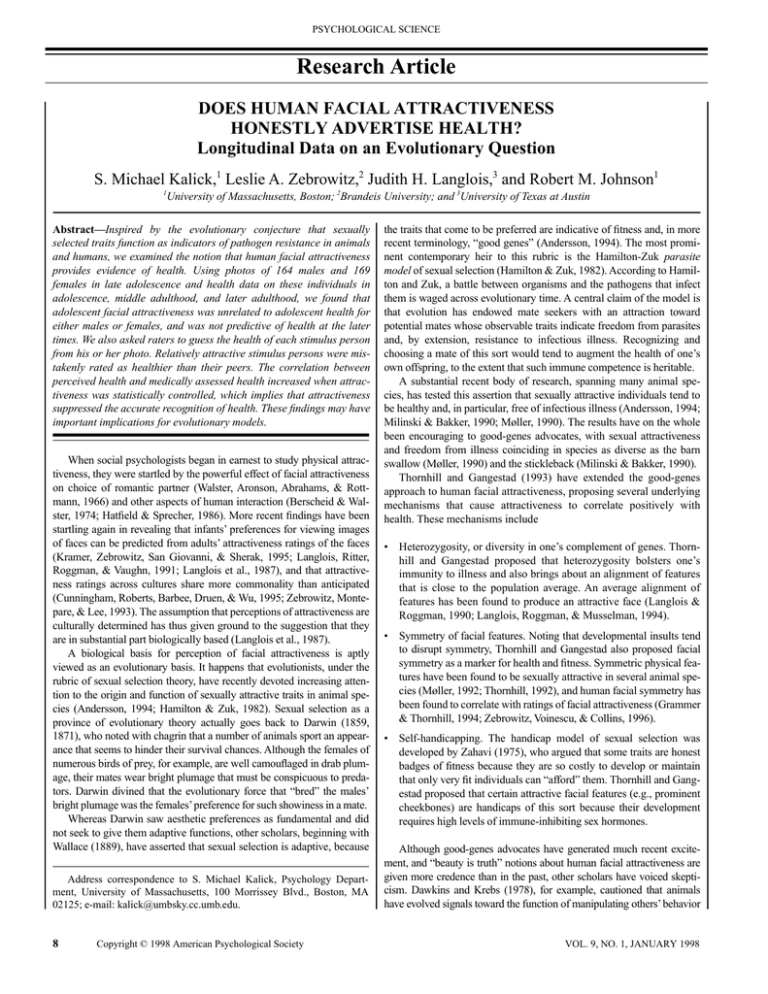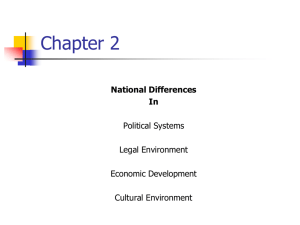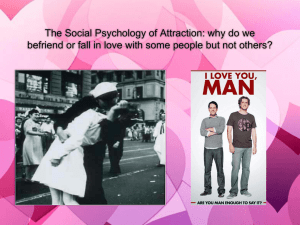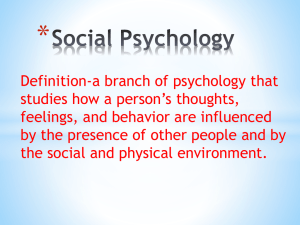
PSYCHOLOGICAL SCIENCE
Research Article
DOES HUMAN FACIAL ATTRACTIVENESS
HONESTLY ADVERTISE HEALTH?
Longitudinal Data on an Evolutionary Question
S. Michael Kalick,1 Leslie A. Zebrowitz,2 Judith H. Langlois,3 and Robert M. Johnson1
1
University of Massachusetts, Boston; 2Brandeis University; and 3University of Texas at Austin
Abstract—Inspired by the evolutionary conjecture that sexually
selected traits function as indicators of pathogen resistance in animals
and humans, we examined the notion that human facial attractiveness
provides evidence of health. Using photos of 164 males and 169
females in late adolescence and health data on these individuals in
adolescence, middle adulthood, and later adulthood, we found that
adolescent facial attractiveness was unrelated to adolescent health for
either males or females, and was not predictive of health at the later
times. We also asked raters to guess the health of each stimulus person
from his or her photo. Relatively attractive stimulus persons were mistakenly rated as healthier than their peers. The correlation between
perceived health and medically assessed health increased when attractiveness was statistically controlled, which implies that attractiveness
suppressed the accurate recognition of health. These findings may have
important implications for evolutionary models.0
When social psychologists began in earnest to study physical attractiveness, they were startled by the powerful effect of facial attractiveness
on choice of romantic partner (Walster, Aronson, Abrahams, & Rottmann, 1966) and other aspects of human interaction (Berscheid & Walster, 1974; Hatfield & Sprecher, 1986). More recent findings have been
startling again in revealing that infants’ preferences for viewing images
of faces can be predicted from adults’ attractiveness ratings of the faces
(Kramer, Zebrowitz, San Giovanni, & Sherak, 1995; Langlois, Ritter,
Roggman, & Vaughn, 1991; Langlois et al., 1987), and that attractiveness ratings across cultures share more commonality than anticipated
(Cunningham, Roberts, Barbee, Druen, & Wu, 1995; Zebrowitz, Montepare, & Lee, 1993). The assumption that perceptions of attractiveness are
culturally determined has thus given ground to the suggestion that they
are in substantial part biologically based (Langlois et al., 1987).
A biological basis for perception of facial attractiveness is aptly
viewed as an evolutionary basis. It happens that evolutionists, under the
rubric of sexual selection theory, have recently devoted increasing attention to the origin and function of sexually attractive traits in animal species (Andersson, 1994; Hamilton & Zuk, 1982). Sexual selection as a
province of evolutionary theory actually goes back to Darwin (1859,
1871), who noted with chagrin that a number of animals sport an appearance that seems to hinder their survival chances. Although the females of
numerous birds of prey, for example, are well camouflaged in drab plumage, their mates wear bright plumage that must be conspicuous to predators. Darwin divined that the evolutionary force that “bred” the males’
bright plumage was the females’ preference for such showiness in a mate.
Whereas Darwin saw aesthetic preferences as fundamental and did
not seek to give them adaptive functions, other scholars, beginning with
Wallace (1889), have asserted that sexual selection is adaptive, because
Address
correspondence to S. Michael Kalick, Psychology Depart0.
ment, University of Massachusetts, 100 Morrissey Blvd., Boston, MA
02125;
e-mail: kalick@umbsky.cc.umb.edu.
fdsfdsfsdfds
8
Copyright © 1998 American Psychological Society
the traits that come to be preferred are indicative of fitness and, in more
recent terminology, “good genes” (Andersson, 1994). The most prominent contemporary heir to this rubric is the Hamilton-Zuk parasite
model of sexual selection (Hamilton & Zuk, 1982). According to Hamilton and Zuk, a battle between organisms and the pathogens that infect
them is waged across evolutionary time. A central claim of the model is
that evolution has endowed mate seekers with an attraction toward
potential mates whose observable traits indicate freedom from parasites
and, by extension, resistance to infectious illness. Recognizing and
choosing a mate of this sort would tend to augment the health of one’s
own offspring, to the extent that such immune competence is heritable.
A substantial recent body of research, spanning many animal species, has tested this assertion that sexually attractive individuals tend to
be healthy and, in particular, free of infectious illness (Andersson, 1994;
Milinski & Bakker, 1990; Møller, 1990). The results have on the whole
been encouraging to good-genes advocates, with sexual attractiveness
and freedom from illness coinciding in species as diverse as the barn
swallow (Møller, 1990) and the stickleback (Milinski & Bakker, 1990).
Thornhill and Gangestad (1993) have extended the good-genes
approach to human facial attractiveness, proposing several underlying
mechanisms that cause attractiveness to correlate positively with
health. These mechanisms include
• Heterozygosity, or diversity in one’s complement of genes. Thornhill and Gangestad proposed that heterozygosity bolsters one’s
immunity to illness and also brings about an alignment of features
that is close to the population average. An average alignment of
features has been found to produce an attractive face (Langlois &
Roggman, 1990; Langlois, Roggman, & Musselman, 1994).
• Symmetry of facial features. Noting that developmental insults tend
to disrupt symmetry, Thornhill and Gangestad also proposed facial
symmetry as a marker for health and fitness. Symmetric physical features have been found to be sexually attractive in several animal species (Møller, 1992; Thornhill, 1992), and human facial symmetry has
been found to correlate with ratings of facial attractiveness (Grammer
& Thornhill, 1994; Zebrowitz, Voinescu, & Collins, 1996).
• Self-handicapping. The handicap model of sexual selection was
developed by Zahavi (1975), who argued that some traits are honest
badges of fitness because they are so costly to develop or maintain
that only very fit individuals can “afford” them. Thornhill and Gangestad proposed that certain attractive facial features (e.g., prominent
cheekbones) are handicaps of this sort because their development
requires high levels of immune-inhibiting sex hormones.
Although good-genes advocates have generated much recent excitement, and “beauty is truth” notions about human facial attractiveness are
given more credence than in the past, other scholars have voiced skepticism. Dawkins and Krebs (1978), for example, cautioned that animals
have evolved signals toward the function of manipulating others’ behavior
VOL. 9, NO. 1, JANUARY 1998
PSYCHOLOGICAL SCIENCE
S.M. Kalick et al.
to the benefit of the signaler, regardless of whether the perceiver is
informed or deceived in the process. Their argument is consistent with a
caveat emptor approach to appearance as a signal for health and fitness.
Biologists have explored processes by which sexually attractive
traits can evolve even though they may not be fitness markers. Simulations and computer models have shown, for example, that trait preferences can arise as an artifact of the process of accurately recognizing
one’s own species (Enquist & Arak, 1993). This line of inquiry has
been known as perceptual-bias theory and research (see also Ryan,
Fox, Wilczynski, & Rand, 1990). Scholars who are skeptical of the
good-genes approach also cite the Fisherian runaway model of sexual
selection (Fisher, 1915, 1958), which theorizes the evolution of attractive traits that may not accurately indicate Darwinian fitness. In principle, a Fisherian process can commence once an attractive (and
heritable) trait arises in a given sex, whether as a fitness marker or as
an artifact of perceptual bias. The attractiveness of such a trait would
make it advantageous for members of that sex to display the trait and
for members of the other sex to prefer the trait in a mate. Fisher
asserted that these evolutionary incentives can cause the preference to
intensify and the trait to become elaborated across generations, until
any initial function of the trait as a fitness indicator becomes eclipsed.
Mathematical modelers such as Lande (1981) have verified that Fisherian processes can occur under a range of initial conditions.
Good-genes theories of human facial attractiveness have thus far
been the subject of few empirical tests. One study (Reis, Wheeler,
Kernis, Spiegel, & Nezlek, 1985), which focused on the relationship
between social interaction and health among college students, did
include an attractiveness variable based on a combination of facial and
body attractiveness. Participants’ visits to the college health service
were coded into nine separate categories. Among women, a significant
negative correlation between attractiveness and number of visits was
reported for one of the nine categories; among men, there was also a
significant correlation between attractiveness and number of visits in
just one category, but that correlation was positive. Overall, little evidence for either a positive or a negative relationship between attractiveness and health was apparent from the findings.
To our knowledge, our research is the first to correlate human facial
attractiveness with physical health as assessed from records of detailed
and repeated medical examinations, which had been conducted in a
study prospectively designed to document the health trajectories of the
participants. Our attractiveness data are based on facial photographs of
male and female participants in late adolescence. The health data are
based on participants’ medical records across adolescence and at two
later times in their lives. These data have enabled us to examine two
issues with regard to facial appearance and health: Do ratings of facial
attractiveness in fact predict health scores? Does facial appearance in
late adolescence allow people to make accurate judgments of the
health of potential mates, and if so, does facial attractiveness help
account for the accuracy of those judgments?
archived at the University of California, Berkeley, Institute of Human
Development (IHD; Clausen, 1993). Participants were born between
1920 and 1929; resided in the vicinity of Berkeley and Oakland, California; and were with few exceptions from Caucasian working- and
middle-class families.
Participants’ health in adolescence was assessed from age 11
through 18 by means of clinical exams and detailed histories. Staff
physicians examined the participants and prepared charts, which were
used by the IHD medical research director to make yearly ratings of
each participant on a 5-point health scale ranging from “no illness” to
“severe illness.” The researchers observed that in adolescence the ratings were largely based on frequency, duration, and severity of infectious conditions such as colds, measles, rubella, and respiratory
infections (Bayer & Snyder, 1950; Bayer, Whissell-Buechy, &
Honzik, 1981). For our research, we calculated adolescent health
scores by averaging the yearly health ratings from age 11 through age
18. The alpha reliability for the composite was .68.1
The health ratings for middle adulthood were compiled on a similar 5-point scale; they were based on a single medical exam and history administered between ages 30 and 36, supplemented for about a
third of the participants with an overnight hospital stay for lab work.
Examining physicians prepared charts, which were converted to health
ratings independently by the two leading IHD medical researchers.
The correlation between their ratings was .63. After discussing their
independent ratings, the researchers jointly produced a “conference
score” for each participant, and it was these scores that we used for the
health ratings for middle adulthood. The conference scores correlated
at greater than .80 with each researcher’s initial assessments.
The health ratings for later adulthood also used a 5-point scale, and
were provided by the participants’ personal physicians when participants were between ages 58 and 66. If a participant had died of a physical illness (n = 3 prior to middle adulthood and n = 22 prior to late
adulthood), he or she was subsequently assigned the lowest health
score. For other causes of death, such as accidents, participants were
excluded from subsequent assessments. As age increased, chronic illnesses tended to have an increasing influence on the health ratings
(Bayer et al., 1981).
The attractiveness ratings we used had been produced for an earlier
study (Zebrowitz, Olson, & Hoffman, 1993) charting the IHD participants’ facial attractiveness across the life span. Photos taken at ages
17, 17.5, and 18 had been converted to slides, and approximately 16
male and 16 female raters judged the attractiveness of each face on a
7-point scale. The ratings obtained produced alpha reliabilities averaging .87 for male faces and .90 for female faces. The ratings were averaged across judges and across the three ages to produce adolescent
attractiveness scores of maximum reliability.
To validate our attractiveness scores as predictors of a mateselection advantage, we examined IHD data with respect to marriage
and children. Only 10 of the participants in our sample never married,
FACIAL ATTRACTIVENESS
AND PHYSICAL HEALTH
1. An anonymous reviewer conjectured that apparently poor health in
adolescence might have been based on the incidence of childhood illnesses
that were actually beneficial to contract at that time rather than later. We
note that the health scores were based on severity of illness and occurrence
of complications rather than mere incidence of illness. The substantial
alpha coefficient across the 8 adolescent years and the significant correlation between health in adolescence and in middle adulthood (r = .19, n =
252, p < .01) indicate that an underlying factor aptly named resistance to
illness contributed to the scores.
Participants and Procedures
The photos and health data for our research were obtained from the
widely known Intergenerational Studies, comprising three longitudinal studies that have been consolidated for research purposes and
VOL. 9, NO. 1, JANUARY 1998
9
PSYCHOLOGICAL SCIENCE
Attractiveness, Health, and Evolution
and they were rated less attractive than the remainder, t(236) = 1.77,
p < .05 (reported probabilities are one-tailed2). Among those who did
marry, the more attractive tended to marry younger (partial r = –.10,
n = 193, p = .07, controlling for sex because males married later than
females). The 29 participants who never had children were less attractive than those who did, t(241) = 1.99, p < .05. However, when those
who never married were excluded and age when first married was controlled, attractiveness was unrelated to number of children (partial
r = .03, n = 177, n.s.), suggesting that any relationship between attractiveness and fecundity was due to mate-selection chances rather than
biological fertility.3 These data agree with prior evidence that facial
attractiveness confers an advantage in mate selection (Walster et al.,
1966; White, 1980).
In that socioeconomic status (SES) has been found to be related to
both attractiveness (Udry & Eckland, 1984) and health (Adler et al.,
1994), and may influence one or both, we used SES as measured by
the Hollingshead Index (Hollingshead & Redlich, 1958) as a covariate
in a series of regressions with adolescent attractiveness as the independent variable and health at each of the three times as the dependent
variable. For the regression analysis predicting adolescent health, SES
was calculated as the mean of the Hollingshead Index scores collected
when participants were born and when they were about 18 years old.
For predicting health in middle adulthood, we defined SES as the
mean of the Hollingshead scores at birth, at age 18, and in middle
adulthood. For predicting health in late adulthood, we averaged Hollingshead scores at birth, at age 18, in middle adulthood, and in late
adulthood to calculate the SES covariate. Sample sizes were 164 males
and 169 females in adolescence, 125 males and 127 females in middle
adulthood, and 56 males and 66 females in later adulthood.
Attractiveness and Health
With SES controlled, adolescent facial attractiveness did not contribute to the prediction of health for either males or females at any of the
ages under review. For adolescent health, the partial rs were –.04, .00,
and –.10 for the full sample, males, and females, respectively, all nonsignificant with a one-tailed alpha of .05. For health in middle adulthood, again controlling for SES, the partial rs for attractiveness were
.05, .03, and .09, for the full sample, males, and females, in each case
nonsignificant. For later adult health, the partial rs were again uniformly
nonsignificant at –.07, –.06, and –.01 for the full sample, males, and
females. The zero-order correlations between attractiveness and health
were very similar to the corresponding partial correlations (see Table 1).
In addition, when we used SES at age 18 as our covariate rather than
averaging our SES measure across time, the partial rs between attractiveness and health were virtually the same as those just reported. The
2. We chose to use one-tailed probabilities, and to set the alpha level at
.05, in order to maximize the chance of discovering a positive relationship
between attractiveness and health. For consistency, we used one-tailed
probabilities throughout, except as noted, when no direction of relationship was hypothesized a priori.
3. The zero-order correlations between attractiveness and number of
children were r = .03, n = 116, for males and r = .11, n = 127, for females,
in neither case significant. Among IHD participants, almost all of whom
found spouses, family planning was likely to have diluted any influence of
attractiveness on family size. The number of children fathered premaritally
or adulterously by the male participants is not known. That item of data
might have been a truer index of reproductive success “in the wild.”
10
Table 1. Correlations between adolescent facial attractiveness
and health at three life stages, along with partial correlations
controlling for socioeconomic status (SES)
Life stage
Adolescence
Males
Females
Middle adulthood
Males
Females
Late adulthood
Males
Females
n
rAH
rAH.S
164
169
.02
–.10
.00
–.10
125
127
.05
.10
.03
.09
56
66
–.02
.04
–.06
–.01
Note. A = adolescent facial attractiveness; H = medically assessed
health; S = composite SES score. All correlations are nonsignificant.
With the sample sizes shown and alpha set at .05, one-tailed, minimum
significant correlations would be approximately r = .13 in adolescence,
r = .15 in middle adulthood, and r = .21 in late adulthood.
correlations and partial correlations were thus arrayed quite closely
about zero, with none significant.4 We examined the standardized scatter
plots and partial regression plots corresponding to each multiple regression and saw no suggestion of a nonlinear relationship involving attractiveness and health.
The ranges of SES, attractiveness, and health were substantial
across participants, and truncated range was unlikely to be responsible
for an absence of correlation between the variables. SES, for example,
was a significant predictor of health. Family SES at about age 18 predicted participants’ health scores in later adulthood substantially,
r = .35, n = 108, p < .001. This is consistent with previous findings
linking SES with health (Adler et al., 1994). Moreover, our null findings are probably not attributable to underpowered tests. If we assume,
for example, a modest population value of r = .25 between adolescent
facial attractiveness and adolescent health as we measured them, given
our sample size of 333 participants and our one-tailed alpha of .05, the
power of our test of the correlation between attractiveness and health
was greater than .99 (Lipsey, 1990).5
PERCEIVED HEALTH: BLINDED BY BEAUTY?
We were intrigued by a recent finding that human attractiveness
tends to receive highest priority for mate selection in geographic areas
4. In view of the finding mentioned earlier that never-married participants were rated less attractive than those who did marry, we compared the
health scores of participants who never married and those who did marry.
There was no significant difference in health score at any of the ages. The
“marriage market” thus seems to have been no more likely to favor healthy
individuals than were our attractiveness raters.
5. Møller (1990), studying barn swallows, and Milinski and Bakker
(1990), studying sticklebacks, found correlations as high as r = .7 between
the magnitude of ornamental traits and criteria of health and fitness. Studies with other species have failed to find the predicted relationships
between sexually attractive traits and health criteria (see Andersson, 1994,
for a summary of research outcomes). No quantitative meta-analysis that
synthesizes the corpus of findings is yet available.
VOL. 9, NO. 1, JANUARY 1998
PSYCHOLOGICAL SCIENCE
S.M. Kalick et al.
most affected by pathogens (Gangestad & Buss, 1993), presumably
because mate seekers in pathogen-ridden areas use the attractiveness
of eligible partners as signs of freedom from disease. We sought to
examine whether facial attractiveness in our sample would also be
taken as a sign of health. We asked a new set of raters to view slides of
the IHD participants and provide impressions of each participant’s
health on a 7-point scale ranging from “poor health” to “excellent
health.” One adolescent slide per IHD participant was shown, based on
the photo taken at age 17. Slides of 130 males and 125 females were
included. We averaged the health perceptions of five male and nine
female raters; the alpha reliability for the composite was .83.
The perceptions of each participant’s health were strongly related
to the previous raters’ attractiveness scores for the same participants,
with rs of .63, .63, and .66 for all participants, male participants, and
female participants, respectively (ps < .001). Though adolescent
attractiveness and health were not related according to our actual
health scores, the raters seem to have associated them quite strongly.
This finding suggests that humans living in areas affected by pathogens might emphasize attractiveness in mate selection because attractiveness has a halo effect on perception of health rather than because
attractiveness is an accurate indicator of health.
Despite their apparently mistaken reliance on attractiveness, the raters were able to perceive adolescent health with some success. Impressions of participants’ health and their adolescent health scores
correlated at r values of .15, .19, and .12 for all participants, males, and
females, respectively (ps < .05, .05, and .10). The modest accuracy of
the ratings of perceived health, coupled with the strong relationship
between perceived health and the inaccurate health cue of attractiveness, prompted us to examine part correlations for perceived health as a
predictor of actual health score, with attractiveness statistically controlled.6 The resulting part correlations were considerably stronger than
the zero-order correlations: Part rs were .24, .24, and .24 for all participants, males, and females (ps < .001, .01, and .01; see Fig. 1). This
finding implies that attractiveness functioned as a suppressor variable
(McClendon, 1994), weakening the relationship between perceived
health and actual health. Using a test developed by Malgady (1987), we
found that the suppression was statistically significant for all participants, t(252) = –2.30, p < .05 (two-tailed), and for the female participants, t(122) = –1.93, p = .05 (two-tailed), in that the part correlations
were significantly stronger than the zero-order correlations.
To observe from a different vantage point how attractiveness moderated the relationship between perceived health and IHD health score,
we divided the participants into an extreme and a moderate subsample
based on attractiveness. The extreme subsample consisted of the top
and bottom attractiveness quartiles, and the moderate subsample comprised the two quartiles adjoining the median. Members of the extreme
subsample were thus conspicuous for their attractiveness or lack of
attractiveness, whereas members of the moderate subsample were relatively inconspicuous in this regard. For the extreme subsample, perceived health did not predict actual health, with nonsignificant rs of
.08, .12, and .03 for the complete subsample, the males, and the
females, respectively. By contrast, the raters were quite accurate in
judging health for the moderate subsample, with perceived health and
IHD health score correlating at r values of .27, .34, and .23 (ps < .001,
6. We used part correlations, also known as semipartial correlations, in
these analyses because a test for statistically comparing them with zeroorder correlations is available.
VOL. 9, NO. 1, JANUARY 1998
Fig. 1. Correlations between raters’ guesses concerning adolescents’
health and medical assessments of their health, along with corresponding
part correlations, controlling for the adolescents’ facial attractiveness.
.01, and .05) for the complete subsample, the males, and the females.7
Thus, only with the distracting effects of attractiveness diminished did
participants’ faces provide trustworthy cues to their health. These findings suggest that sexually selected traits unrelated to fitness may
obscure and thus weaken any possible effects of “honest” fitness cues
on mate selection.
IMPLICATIONS
Social scientists have increasingly concerned themselves with sexual selection, in theories of human mating systems and sexual strategies (Buss & Schmitt, 1993; Symons, 1979). In each of these theories,
obtaining a mate of high quality gives one an evolutionary advantage.
The present research was concerned with the nature of the advantage
that accrues from obtaining a facially attractive mate. Good-genes formulations hypothesize an attractive mate as offering the “good sense”
(Cronin, 1991) advantage of superior heritable fitness. An alternative
formulation, associated chiefly with Fisher, asserts that an attractive
mate may simply offer the “good taste” (Cronin, 1991) advantage of
superior heritable attractiveness (Fisher, 1915, 1958). Attractiveness in
the Fisherian model may thus take on a life of its own, becoming its
own source of quality rather than indicating some more fundamental
source.
Our research, examining the relationship between adolescent facial
attractiveness and health among an American sample, failed to identify
a good-sense advantage in the preference for facial attractiveness. On
the contrary, there was evidence that people are “blinded by beauty,” in
that facial attractiveness suppressed the correlation between perceived
7. Based on Fisher’s r-to-Z transformations, with males and females
combined, the correlation between perceived health and actual health
tended to be stronger among the moderate subsample than the extreme
subsample, Z = 1.57, p = .06.
11
PSYCHOLOGICAL SCIENCE
Attractiveness, Health, and Evolution
health and actual health. It is noteworthy that our findings are based on
medical assessments across all of adolescence, supplemented by two
later assessments. The adolescent health scores, primarily reflecting
freedom from infectious illness between ages 11 and 18 (Bayer &
Snyder, 1950; Bayer et al., 1981), seem a reasonable operationalization of Hamilton and Zuk’s (1982) notion of parasite resistance. The
longitudinal health data two and four-plus decades beyond adolescence offered a chance to probe for illness vulnerabilities that might
not have been apparent in the participants’ youth.
We would have liked to pursue leads suggested by Symons (1979)
and Buss and Schmitt (1993) by focusing attention on reproductive
health criteria such as fertility problems and number of miscarriages.
The specific data were not available to us (although conditions such as
these had been reckoned in the health scores). Most contributions to
the literature inspired by Hamilton and Zuk (1982), on “showy” traits
as fitness indicators, have relied on relatively simple health and fitness
criteria with one or a few components. Milinski and Bakker (1990),
for example, used a ratio of weight to length as their fitness criterion
for sticklebacks, and Møller (1990) counted parasitic mite loads as a
health criterion among barn swallows. Our more comprehensive
health variable among human participants was made possible by the
extraordinary IHD research program, and by the researchers’ generosity in archiving their key data.
We caution that our failure to find a good-sense basis for human
sexual selection based on facial attractiveness does not rule out other
good-sense elements in human sexual selection. For example, research
has shown that men and women with symmetric faces (Grammer &
Thornhill, 1994) and women with a low waist-to-hip ratio (Singh,
1993) tend to be sexually preferred, and there is some evidence that
these are honest indicators of fertility or other aspects of physical
health (Shackelford & Larsen, 1997; Singh, 1993). Also, Symons
(1979) and Buss and Schmitt (1993) have provided a good-sense rationale, based on present and future fertility, for the finding that rated
attractiveness declines with age even from the late teens to early 30s
(Zebrowitz, Olson, & Hoffman, 1993). Our research eliminated age as
a confound by holding it constant. Among stimulus persons between
17 and 18 years old, attractiveness did not reveal health but rather
seems to have masked it.
Our findings hint at a blend of truth and deception in human adolescent facial appearance as an indicator of health—truth, in that perceived health did correlate somewhat with the medical health ratings,
and deception, in that attractiveness was found to suppress that correlation. The strong correlations we observed between facial attractiveness and perceived health suggest a possible earlier epoch when
attractive features did signify actual health (although the finding could
simply be due to an attractiveness halo). If such attractive and honest
indicators did exist, Fisherian logic (Fisher, 1915, 1958) stipulates that
there would have been an evolutionary incentive to display those features for reproductive advantage regardless of one’s health status.
Mate seekers could then have evolved a disposition to distinguish
between honest and deceptive displays, but Fisherian logic suggests
that the incentive to do so might have been quite weak. Attractive features, even though deceptive about health, would still have been valuable in a mate to the extent that they increased the likely attractiveness
of one’s own offspring; detecting such a deception might not have
been advantageous, and mate seekers might not have evolved much
skill at distinguishing honest health indicators from deceptively attractive features.
Dawkins and Krebs (1978) were more comfortable framing their
12
analysis of intraspecies signals, such as fitness indicators, in terms of
“manipulation” than in terms of “deception.” They characterized those
signals as typically conveying a blend of accurate and manipulative
information. “Advertisements,” they wrote, “are not there to inform, or
to misinform, they are there to persuade” (Dawkins & Krebs, 1978, p.
305; italics in original). The mix of truth and manipulation in sexual
selection, as well as the balance between good sense and good taste,
remains to be more fully delineated in future research.
Acknowledgments—This research was supported by Grant MH42684 from
the National Institute of Mental Health (L.A.Z), Grant HD 21332 from the
National Institutes of Health (J.H.L.), and a University of Massachusetts,
Boston, internal grant (S.M.K.). We thank the Institute of Human Development (IHD) at the University of California, Berkeley, for access to the data
archives used in this study, Carol Huffine and Barbara Burek for facilitating
our data acquisition from the IHD, Luminita Voinescu for collecting the data
on perceived health, and David Buss, Del Thiessen, Walter Wilczynski, Dennis McFadden, and Celia Moore for comments on drafts of the manuscript.
REFERENCES
Adler, N.E., Boyce, T., Chesney, M.A., Cohen, S., Folkman, S., Kahn, R.L., & Syme, S.L.
(1994). Socioeconomic status and health: The challenge of the gradient. American
Psychologist, 49, 15–24.
Andersson, M. (1994). Sexual selection. Princeton, NJ: Princeton University Press.
Bayer, L.M., & Snyder, M.M. (1950). Illness experience of a group of normal children.
Child Development, 21, 93–120.
Bayer, L.M., Whissell-Buechy, D., & Honzik, M.P. (1981). Health in the middle years. In
D.H. Eichorn, J.A. Clausen, N. Haan, M.P. Honzik, & P.H. Mussen (Eds.), Present
and past in middle life (pp. 55–88). New York: Academic Press.
Berscheid, E., & Walster, E. (1974). Physical attractiveness. In L. Berkowitz (Ed.),
Advances in experimental social psychology (Vol. 7, pp. 157–215). New York: Academic Press.
Buss, D.M., & Schmitt, D.P. (1993). Sexual strategies theory: An evolutionary perspective
on human mating. Psychological Review, 100, 204–232.
Clausen, J.A. (1993). American lives: Looking back at the children of the Great Depression. New York: Free Press.
Cronin, H. (1991). The ant and the peacock. Cambridge, England: Cambridge University
Press.
Cunningham, M.R., Roberts, A.R., Barbee, A.P., Druen, P.B., & Wu, C.-H. (1995). “Their
ideas of beauty are, on the whole, the same as ours”: Consistency and variability in
the cross-cultural perception of female physical attractiveness. Journal of Personality and Social Psychology, 68, 261–279.
Darwin, C. (1859). On the origin of species by means of natural selection. London: Murray.
Darwin, C. (1871). The descent of man, and selection in relation to sex. London: Murray.
Dawkins, R., & Krebs, J.R. (1978). Animal signals: Information or manipulation? In J.R.
Krebs & N.B. Davies (Eds.), Behavioral ecology: An evolutionary approach (pp.
282–309). Sunderland, MA: Sinauer Associates.
Enquist, M., & Arak, A. (1993). Selection of exaggerated male traits by female aesthetic
senses. Nature, 361, 446–448.
Fisher, R.A. (1915). The evolution of sexual preference. Eugenics Review, 7, 184–192.
Fisher, R.A. (1958). The genetical theory of natural selection (2nd ed.). New York: Dover.
Gangestad, S.W., & Buss, D.M. (1993). Pathogen prevalence and human mate preferences.
Ethology and Sociobiology, 14, 89–96.
Grammer, K., & Thornhill, R. (1994). Human (Homo sapiens) facial attractiveness and
sexual selection: The role of symmetry and averageness. Journal of Comparative
Psychology, 108, 233–242.
Hamilton, W.D., & Zuk, M. (1982). Heritable true fitness and bright birds: A role for parasites? Science, 218, 384–387.
Hatfield, E., & Sprecher, S. (1986). Mirror, mirror: The importance of looks in everyday
life. Albany: State University of New York Press.
Hollingshead, A.B., & Redlich, F.C. (1958). Social class and mental illness. New York: Wiley.
Kramer, S., Zebrowitz, L.A., San Giovanni, J.P., & Sherak, B. (1995). Infant preferences for
attractiveness and babyfaceness. In B.G. Bardy, R.J. Bootsma, & Y. Guiard (Eds.),
Studies in perception and action III (pp. 389–392). Hillsdale, NJ: Erlbaum.
Lande, R. (1981). Models of speciation by sexual selection on polygenic traits. Proceedings of the National Academy of Sciences, USA, 78, 3721–3725.
Langlois, J.H., Ritter, J.M., Roggman, L.A., & Vaughn, L.S. (1991). Facial diversity and
infant preferences for attractive faces. Developmental Psychology, 27, 79–84.
Langlois, J.H., & Roggman, L.A. (1990). Attractive faces are only average. Psychological
Science, 1, 115–121.
Langlois, J.H., Roggman, L.A., Casey, R.J., Ritter, J.M., Rieser-Danner, L.A., & Jenkins,
V.Y. (1987). Infant preferences for attractive faces: Rudiments of a stereotype?
Developmental Psychology, 23, 363–369.
VOL. 9, NO. 1, JANUARY 1998
PSYCHOLOGICAL SCIENCE
S.M. Kalick et al.
Langlois, J.H., Roggman, L.A., & Musselman, L. (1994). What is average and what is not
average about attractive faces? Psychological Science, 5, 214–220.
Lipsey, M.W. (1990). Design sensitivity: Statistical power for experimental research.
Newbury Park, CA: Sage.
Malgady, R.G. (1987). Contrasting part correlations in regression models. Educational and
Psychological Measurement, 47, 961–965.
McClendon, M.J. (1994). Multiple regression and causal analysis. Itasca, IL: F.E. Peacock.
Milinski, M., & Bakker, T.C.M. (1990). Female sticklebacks use male coloration in mate
choice and hence avoid parasitized males. Nature, 344, 330–333.
Møller, A.P. (1990). Effects of a haematophagous mite on the barn swallow (hirundo rustica): A test of the Hamilton and Zuk hypothesis. Evolution, 44, 771–784.
Møller, A.P. (1992). Female swallow preference for symmetrical male sexual ornaments.
Nature, 357, 238–240.
Reis, H.T., Wheeler, L., Kernis, M.H., Spiegel, N., & Nezlek, J. (1985). On specificity in
the impact of social participation on physical and psychological health. Journal of
Personality and Social Psychology, 48, 456–471.
Ryan, M.J., Fox, J.H., Wilczynski, W., & Rand, A.S. (1990). Sexual selection for sensory
exploitation in the frog Physalaemus pustulosus. Nature, 343, 66–67.
Shackelford, T.K., & Larsen, R.J. (1997). Facial asymmetry as an indicator of psychological, emotional, and physiological distress. Journal of Personality and Social Psychology, 72, 456–466.
Singh, D. (1993). Adaptive significance of female physical attractiveness: Role of waist-tohip ratio. Journal of Personality and Social Psychology, 65, 293–307.
Symons, D. (1979). The evolution of human sexuality. New York: Oxford University Press.
VOL. 9, NO. 1, JANUARY 1998
Thornhill, R. (1992). Fluctuating asymmetry and the mating system of the Japanese scorpionfly, Panorpa japonica. Animal Behavior, 44, 867–879.
Thornhill, R., & Gangestad, S.W. (1993). Human facial beauty: Averageness, symmetry,
and parasite resistance. Human Nature, 4, 237–269.
Udry, J.R., & Eckland, B.K. (1984). Benefits of being attractive: Differential payoffs for
men and women. Psychological Reports, 54, 47–56.
Wallace, A.R. (1889). Darwinism (2nd ed.). London: Macmillan.
Walster, E., Aronson, V., Abrahams, D., & Rottmann, L. (1966). Importance of physical attractiveness in dating behavior. Journal of Personality and Social Psychology, 4, 508–516.
White, G.L. (1980). Physical attractiveness and courtship progress. Journal of Personality
and Social Psychology, 39, 660–668.
Zahavi, A. (1975). Mate selection—A selection for a handicap. Journal of Theoretical
Biology, 53, 205–214.
Zebrowitz, L.A., Montepare, J.M., & Lee, H.K. (1993). They don’t all look alike: Individuated impressions of other racial groups. Journal of Personality and Social Psychology, 65, 85–101.
Zebrowitz, L.A., Olson K., & Hoffman, K. (1993). Stability of babyfaceness and attractiveness across the life span. Journal of Personality and Social Psychology, 64, 453–466.
Zebrowitz, L.A., Voinescu, L., & Collins, M.A. (1996). “Wide-eyed” and “crooked-faced”:
Determinants of perceived and real honesty across the life span. Personality and
Social Psychology Bulletin, 22, 1258–1269.
(RECEIVED 10/16/96; ACCEPTED 1/15/97)
13







